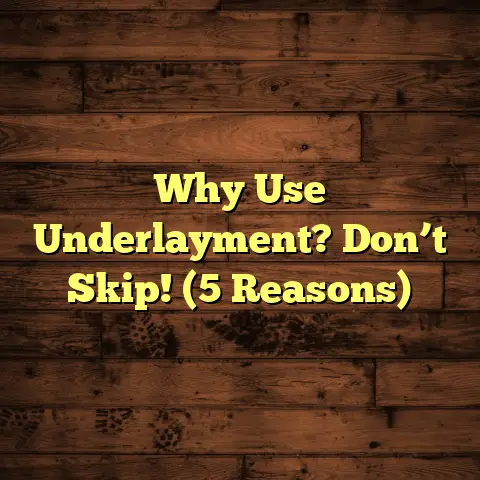Hardwood Floor Material Cost? (2 Quotes, Before You Pay!)
(2 Quotes, Before You Pay!)
I’m Mike, and I’ve been laying down hardwood for over 20 years. I’ve seen it all, trust me.But one thing that gets me every time is seeing homeowners get blindsided by the real cost of hardwood flooring. They fall in love with that beautiful oak or that exotic Brazilian cherry, envisioning cozy evenings and elegant dinner parties.
Then, BAM! The quotes come in, and suddenly that dream floor feels more like a financial nightmare.
It’s frustrating, right? You’re not alone. I can’t tell you how many times I’ve had to gently break the news that their initial budget is, shall we say, ambitious.
That’s why I’m writing this. I want to arm you with the knowledge you need to navigate the wild world of hardwood flooring costs. We’ll break down the types, the hidden expenses, and, most importantly, how to get quotes that don’t leave you weeping into your wallet.
So, grab a cup of coffee, settle in, and let’s get you ready to make some smart flooring decisions.
Section 1: Understanding Hardwood
Flooring Types
Okay, first things first, let’s talk about the different types of hardwood flooring. It’s not all just “wood,” you know? There are a few key players:
-
Solid Hardwood: This is the real deal. Planks milled from a single piece of wood. It’s beautiful, durable, and can be refinished multiple times. But, it’s also the most expensive and can be sensitive to moisture.
-
Engineered Hardwood: Think of this as plywood, but with a real hardwood veneer on top. It’s more stable than solid hardwood, meaning it’s less likely to warp or cup with changes in humidity. Plus, it’s generally more affordable.
-
Laminate Flooring: Okay, this isn’t technically hardwood. It’s a synthetic material with a photographic image of wood on top. It’s the most budget-friendly option, and it’s very durable and easy to clean. However, it doesn’t have the same feel or resale value as real wood.
So, how do these price variances play out in the real world? Let’s look at some sample quotes I’ve gotten from my suppliers recently. Keep in mind, these are averages and can vary depending on your location and the specific product:
Quote 1: “The Wood Whisperer” (Local Supplier)
| Flooring Type | Material Cost | | (per sq ft) | | ——————— | ————- | | Solid Hardwood (Oak) | \$8 – \$12 | | Engineered Hardwood | \$5 – \$9 | | Laminate (Wood-look) | \$2 – \$4 |
Quote 2: “Flooring Fantastic” (Online Retailer)
| Flooring Type | Material Cost | | (per sq ft) | | ——————— | ————- | | Solid Hardwood (Oak) | \$7 – \$11 | | Engineered Hardwood | \$4 – \$8 | | Laminate (Wood-look) | \$1.50 – \$3.50 |
As you can see, there’s a pretty significant price range, even within the same type of flooring. That’s because there are other factors at play, which we’ll dive into next.
Section 2: Factors Influencing Hardwood Floor
Material Costs
Alright, let’s get into the nitty-gritty of what drives up (or down) the cost of hardwood. It’s not just about the type of flooring; it’s about the details within each type.
-
Wood Species: Oak and maple are generally more affordable than exotic woods like Brazilian cherry or walnut. The rarity and demand for a particular species directly impact the price.
-
Quality: This refers to the grade of the wood, which is determined by the number of knots, color variations, and other imperfections. Higher grades (like “select” or “clear”) will cost more because they have fewer imperfections.
-
Finish: Pre-finished flooring (where the finish is applied at the factory) is usually more expensive than unfinished flooring (which you have to sand and finish yourself). However, pre-finished flooring can save you time and hassle.
-
Thickness: For solid hardwood, the thicker the plank, the more expensive it will be. Thicker planks can be sanded and refinished more times, extending the life of your floor.
-
Regional Pricing & Availability: Just like gas prices, flooring costs can vary depending on where you live. If a particular wood species is readily available in your area, it will likely be more affordable. Shipping costs can also play a significant role.
I spoke with Sarah Miller, a flooring specialist at a national distributor, and she emphasized the importance of considering these factors. “Homeowners often focus solely on the type of wood, but the quality and finish can have a huge impact on the final cost,” she told me.
“Also, don’t underestimate the impact of shipping costs, especially for large orders or exotic species.”
Section 3: The Importance of Accurate Budgeting
Okay, let’s talk about the B-word: Budget. I know, it’s not the most exciting topic, but it’s absolutely crucial.
According to a recent survey by HomeAdvisor, nearly 50% of homeowners underestimate the cost of their home improvement projects, including flooring. That’s a huge number!
I’ve seen it countless times. People walk in with \$5,000 expecting to do their entire house in solid hardwood. Then reality hits.
Why does this happen? Well, there are a few reasons:
-
Underestimating Material Needs: It’s easy to underestimate how much flooring you actually need. Don’t forget to account for waste (extra material for cuts and mistakes). I usually recommend adding 10-15% to your total square footage.
-
Ignoring Hidden Costs: We’ll get into these in more detail later, but things like underlayment, adhesives, and trim can add up quickly.
-
Failing to Get Multiple Quotes: This is the biggest mistake I see. You need to shop around!
Speaking of quotes, let’s look at a couple more examples:
Quote 3: “Quick Floors” (Local Contractor)
- Solid Hardwood (Oak): \$9 per sq ft (material only)
- Includes: Standard grade wood, basic finish
- Excludes: Underlayment, removal of old flooring, trim
Quote 4: “Premium Flooring Solutions” (Regional Supplier)
- Solid Hardwood (Oak): \$11 per sq ft (material only)
- Includes: Higher grade wood, upgraded finish
- Excludes: Underlayment, removal of old flooring, trim
Notice how the prices are different, even for the same type of wood? That’s because of the quality of the materials and the finish.
The key takeaway here is to get at least two quotes, preferably three or more. This will give you a good sense of the average cost in your area and help you identify any outliers.
Section 4: What’s Included in the
Material Cost?
This is where things can get a little tricky. What exactly are you paying for when you buy hardwood flooring materials?
Typically, the material cost includes the flooring planks themselves. However, it’s important to clarify what else is included (or, more importantly, not included) in the quote.
Here are some common items that may or may not be included:
-
Underlayment: This is a layer of material that goes between the subfloor and the hardwood flooring. It helps to cushion the floor, reduce noise, and provide a moisture barrier.
-
Shipping: If you’re ordering online or from a supplier that’s not local, shipping costs can be significant.
-
Taxes: Don’t forget to factor in sales tax!
-
Adhesives/Fasteners: Depending on the type of flooring and installation method, you may need to purchase adhesives or fasteners (nails, staples, etc.).
-
Trim/Moldings: This includes baseboards, quarter round, and transition strips. These are used to cover the edges of the floor and create a finished look.
Now, let’s talk about those potential hidden costs. These are the things that might not be explicitly mentioned in the quote, but can still add up.
-
Subfloor Preparation: If your subfloor is uneven or damaged, you may need to repair or level it before installing the new flooring. This can involve patching holes, sanding down high spots, or even replacing sections of the subfloor.
-
Removal of Old Flooring: Removing old carpet, tile, or vinyl flooring can be a time-consuming and labor-intensive process. Some contractors will include this in their installation quote, while others will charge extra.
-
Furniture Moving: You’ll need to move all of your furniture out of the room before the flooring can be installed. Some contractors will offer this service for an additional fee.
-
Waste Disposal: Getting rid of the old flooring and any construction debris can also cost you money.
Always, always ask for a detailed breakdown of what’s included in the quote. Don’t be afraid to ask questions and clarify any ambiguities.
Section 5: The Role of Installation Costs
Okay, we’ve talked a lot about material costs, but let’s not forget about the other half of the equation: installation.
Installation costs can vary widely depending on several factors:
-
Complexity of the Project: A simple rectangular room will be cheaper to install than a room with lots of angles or curves.
-
Type of Flooring: Solid hardwood is generally more difficult and time-consuming to install than engineered hardwood or laminate.
-
Geographic Location: Labor costs vary depending on where you live.
-
Contractor Expertise: A more experienced contractor will likely charge more, but they may also do a better job and be able to complete the project more quickly.
So, what are the average installation costs? According to Remodeling Calculator, the national average for hardwood floor installation is between \$6 and \$12 per square foot.
This includes the cost of labor, as well as any necessary materials like nails, adhesives, and underlayment.
I remember one time, I was hired to install hardwood in a customer’s kitchen. They had tried to DIY it themselves, but they quickly realized it was more difficult than they thought.
They had made a lot of mistakes, which meant I had to spend extra time fixing their errors before I could even start installing the new flooring. In the end, it cost them more than if they had just hired a professional in the first place.
That’s why it’s so important to choose the right professional. Don’t just go with the cheapest quote. Look for someone who is experienced, licensed, and insured.
Section 6: Comparing Quotes and Making
Informed Decisions
Alright, you’ve got your quotes in hand. Now what?
Here’s a step-by-step guide to comparing quotes and making an informed decision:
-
Review Each Quote Carefully: Make sure you understand what’s included and what’s not. Look for any hidden fees or charges.
-
Compare Apples to Apples: Make sure you’re comparing quotes for the same type and quality of flooring. If one quote is for a higher grade of wood, it’s going to be more expensive.
-
Look for Red Flags: Be wary of quotes that are significantly lower than the average. This could be a sign of low-quality materials or inexperienced labor.
-
Check References: Ask each contractor for references from past clients. Call those references and ask about their experience.
-
Read Reviews: Check online review sites like Yelp or Google Reviews to see what other people are saying about the contractor.
-
Ask Questions: Don’t be afraid to ask questions! Clarify any ambiguities and make sure you understand all the terms and conditions.
-
Negotiate: Once you’ve narrowed down your choices, try to negotiate the price. You might be able to get a discount if you’re willing to pay in cash or if you’re flexible with the installation schedule.
Remember, the goal is to find a contractor who is reputable, experienced, and offers a fair price. Don’t be afraid to walk away if something doesn’t feel right.
Red Flags to Watch Out For:
-
Unlicensed or Uninsured Contractors: This is a huge risk. If something goes wrong, you’ll be on the hook for any damages.
-
Demanding Full Payment Upfront: A reputable contractor will usually only ask for a small deposit upfront.
-
Vague or Unclear Quotes: A detailed quote is a sign of professionalism.
-
Pressure Tactics: If a contractor is pressuring you to sign a contract immediately, that’s a red flag.
Conclusion:
So, there you have it. Everything you need to know about hardwood floor material costs.
I hope this article has helped you feel more informed and prepared to tackle your flooring project. Remember, the key is to do your research, get multiple quotes, and ask questions.
By taking the time to educate yourself, you can avoid costly mistakes and end up with the beautiful, durable hardwood floors you’ve always dreamed of.
Now, go forth and floor! You got this.





